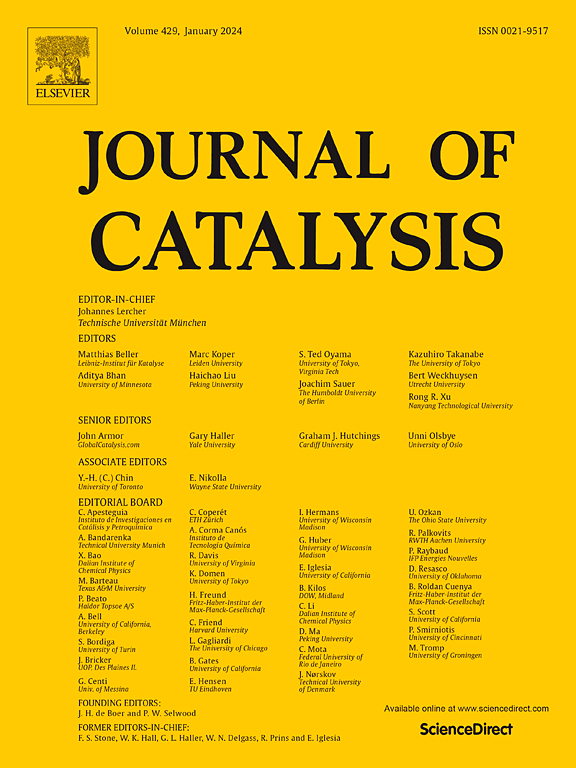重温Cr-MIL-101在水相中催化的葡萄糖异构化和外映异构化:动力学和失活机制
IF 6.5
1区 化学
Q2 CHEMISTRY, PHYSICAL
引用次数: 0
摘要
了解失活过程的动力学和机理有助于设计更有效的策略来提高催化剂的功能。本文研究了Cr-MIL-101催化剂在水相葡萄糖异构化和外映异构化过程中的失活机理。对合成方案和后活化影响的研究排除了在密闭纳米笼中传质限制作为有限催化活性来源的可能性。同位素示踪和核磁共振谱分析结果表明,甘露糖的形成有两种机制,即分子内1,2 -碳位移和两步异构化。热力学分析表明,cr - mil -101催化的水相葡萄糖转化表现出低内在活性和失活现象。理论计算证实了框架结构中三核铬(III)簇的非选择性,它们对己糖(葡萄糖、果糖和甘露糖)具有相当的吸附亲和性。此外,残留的对苯二甲酸、溶剂水和某些副产物可以与Cr位点结合,表明催化剂失活主要是由于Cr位点阻断。在此基础上,建立了一套涵盖失活最相关特征的广义现象学动力学和失活动力学模型,并通过实验数据进行了验证。这些模型定量地描述了动力学和失活行为,明确地说明了竞争结合的潜在机制。最后,讨论了由模型回归分析得出的动力学参数与潜在反应途径的关系。提出了提高本征催化活性和减轻催化剂失活的潜在策略。本文章由计算机程序翻译,如有差异,请以英文原文为准。


Revisiting glucose isomerization and epimerization catalyzed by Cr-MIL-101 in aqueous phase: Kinetics and deactivation mechanism
Understanding the kinetics and mechanism of deactivation process favors the design of more effective strategies to improve catalyst function. We herein investigate the deactivation mechanism of Cr-MIL-101 catalyst during aqueous-phase glucose isomerization and epimerization. The study on effects of synthesis protocols and post-activation excludes the possibility of mass-transfer limitation in confined nanocage as the origin of limited catalytic activity. Contrary to the previous observation, the isotopic-tracer and NMR spectroscopy demonstrates that the formation of mannose proceeds by two mechanisms, i.e., the intramolecular 1, 2-carbon shift and two-step isomerization. Thermodynamic profiling reveals that Cr-MIL-101-catalyzed aqueous-phase glucose transformation exhibits a low intrinsic activity and deactivation phenomenon. Theoretical calculations confirm the non-selective nature of trinuclear chromium (III) clusters within the framework architecture, which demonstrate comparable adsorption affinities toward hexoses (glucose, fructose, and mannose). Additionally, the residual terephthalic acids, solvent water, and certain by-products can bind to the Cr sites, indicating that catalyst deactivation is primarily due to Cr-site-blocking. Based on these findings, a set of generalized phenomenological kinetic and deactivation kinetics models capturing the most relevant features of deactivation were developed and validated by experimental dataset. These models quantitatively describe the kinetic and deactivation behaviors, explicitly accounting for the underlying mechanism of competitive binding. Eventually, kinetic parameters derived from model regression analysis are discussed in relation to the underlying reaction pathways. The potential strategies to enhance intrinsic catalytic activity and mitigate catalyst deactivation are proposed.
求助全文
通过发布文献求助,成功后即可免费获取论文全文。
去求助
来源期刊

Journal of Catalysis
工程技术-工程:化工
CiteScore
12.30
自引率
5.50%
发文量
447
审稿时长
31 days
期刊介绍:
The Journal of Catalysis publishes scholarly articles on both heterogeneous and homogeneous catalysis, covering a wide range of chemical transformations. These include various types of catalysis, such as those mediated by photons, plasmons, and electrons. The focus of the studies is to understand the relationship between catalytic function and the underlying chemical properties of surfaces and metal complexes.
The articles in the journal offer innovative concepts and explore the synthesis and kinetics of inorganic solids and homogeneous complexes. Furthermore, they discuss spectroscopic techniques for characterizing catalysts, investigate the interaction of probes and reacting species with catalysts, and employ theoretical methods.
The research presented in the journal should have direct relevance to the field of catalytic processes, addressing either fundamental aspects or applications of catalysis.
 求助内容:
求助内容: 应助结果提醒方式:
应助结果提醒方式:


